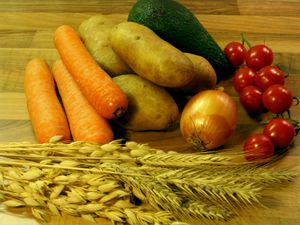Difference between revisions of "Food"
m (link corrected) |
|||
| Line 16: | Line 16: | ||
:*It must be taken into account that the production of 1 kg meat requires 7 to 16 kg of vegetable matter.<ref>[http://www.situations.org.uk/_uploaded_pdfs/KateThompsonwhatyoucandoresource.pdf Kate Thompson: What you can do resource - facts and figures about resource consumption for food production.]</ref> | :*It must be taken into account that the production of 1 kg meat requires 7 to 16 kg of vegetable matter.<ref>[http://www.situations.org.uk/_uploaded_pdfs/KateThompsonwhatyoucandoresource.pdf Kate Thompson: What you can do resource - facts and figures about resource consumption for food production.]</ref> | ||
:*In addition, it takes 2000 to 3000 litres of [[water]] to produce 1 kg of meat, it only takes 100 litres of water to grow 1 kg of grain. Water will be a very valuable commodity on Mars, so the first generation of settlers may well be vegetarian by necessity. | :*In addition, it takes 2000 to 3000 litres of [[water]] to produce 1 kg of meat, it only takes 100 litres of water to grow 1 kg of grain. Water will be a very valuable commodity on Mars, so the first generation of settlers may well be vegetarian by necessity. | ||
| − | *Growing [[insects]] and their larvea (e.g. flour worms or [[flies|fly maggots]]) can provide valuable proteins and might consume just [[waste biomass|waste | + | *Growing [[insects]] and their larvea (e.g. flour worms or [[flies|fly maggots]]) can provide valuable proteins and might consume just [[waste biomass recycling|waste biomass]]. |
*[[Algae]] | *[[Algae]] | ||
*Some food (possibly [[Genetic engineering|genetically modified]]) may be grown in the Martian atmosphere. Results from the Phoenix lander indicate that some vegetables may be grown in caves safe from radiation. | *Some food (possibly [[Genetic engineering|genetically modified]]) may be grown in the Martian atmosphere. Results from the Phoenix lander indicate that some vegetables may be grown in caves safe from radiation. | ||
Revision as of 10:41, 4 November 2012
The amount of Food for human beings that can be brought from Earth to Mars is limited, and the logistics of a continued food transport for the long term is expensive. Especially an autonomous colony needs it's own food production. Reasons for this are cost reduction and the achievement of independence from Earth. Last but not least, the own food can be of higher quality and fresh, including a natural mix of vitamins and minerals.
Contents
Food that can be brought from Earth
- Several varieties of dehydrated food.
- Natural food that contains large amounts of fat and carbohydrates, such as nuts.
- Concentrated fruit juice.
- Light weight, high energy foods with a long shelf-life.
Local Production Methods
- Vegetable can be grown in greenhouses or on green walls.
- Proteins, fat and carbohydrates can be produced by a biotechnological factory
- In-vitro meat
- Animals, such as chicken or fish, may be raised in sections of greenhouses.
- It must be taken into account that the production of 1 kg meat requires 7 to 16 kg of vegetable matter.[1]
- In addition, it takes 2000 to 3000 litres of water to produce 1 kg of meat, it only takes 100 litres of water to grow 1 kg of grain. Water will be a very valuable commodity on Mars, so the first generation of settlers may well be vegetarian by necessity.
- Growing insects and their larvea (e.g. flour worms or fly maggots) can provide valuable proteins and might consume just waste biomass.
- Algae
- Some food (possibly genetically modified) may be grown in the Martian atmosphere. Results from the Phoenix lander indicate that some vegetables may be grown in caves safe from radiation.
Nutrition and Energy Calculations
Assuming we have no genetically modified plants for the Martian colony we can only try to provide optimized conditions in the greenhouse for maximization of harvest. The following calculation is, therefore, based upon terrestrial agricultural figures.
Potatoes
Under best conditions on Earth it is possible to grow 3 kg potatoes per m2 per year. 3 kg potatoes contain 8820 kJ energy, which roughly serves the energy requirements for one person for one day. So, a person needs about 365 m2 cropland at a minimum to survive.
Wheat
The average harvest of wheat is 0.28 kg per m2 per year. Under best conditions it is possible to grow 0.7 kg per m2 per year. 0.7 kg wheat contain 9198 kJ energy, which roughly serves the energy requirements for one person for one day. So, a person needs about 365 m2 cropland at a minimum to survive.
Facts and figures
- Sweden: 26260 kg potatoes per hectare [2]
- Sweden: about 6000 kg wheats per hectare [3]
- "Plain boiled potatoes are naturally low in fat and provide 72 kcal/100g (306 KJ/100g)" [4]
- "Wheat flour provides 310 - 340 kcal/100g (1320 - 1450 KJ/100g)"[5]
Open issues
- What sorts of food are required to keep the settlers healthy? We need a nutrition plan on a scientific base.
- How much vegetable is needed to produce 1 kg pork, chicken, rabbit, beef, flour worm, etc.?
- What esculent animal/insect/worm etc. needs the smallest amount of vegetable? The best mass ratio is sought-after. A list would be highly welcome.
- What is known about needed vitamins and minerals?
- Is it possible to make artificial food with an artificial mixture of vitamins and minerals, allowing humans to keep well and fit?







